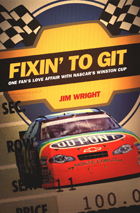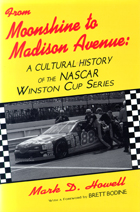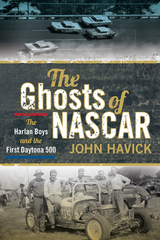3 books about Stock car racing

Fixin to Git
One Fan's Love Affair with NASCAR's Winston Cup
Jim Wright
Duke University Press, 2002
In the past twenty years, big-time stock-car racing has become America’s fastest growing spectator sport. Winston Cup races draw larger audiences—at the tracks and on television—than any other sport, and drivers like Dale Jarrett, Jeff Gordon, and Mark Martin have become cultural icons whose endorsements command millions. What accounts for NASCAR’s surging popularity?
For years a “closeted” NASCAR fan, Professor Jim Wright took advantage of a sabbatical in 1999 to attend stock-car races at seven of the Winston Cup’s legendary venues: Daytona, Indianapolis, Darlington, Charlotte, Richmond, Atlanta, and Talladega. The “Fixin’ to Git Road Tour” resulted in this book—not just a travelogue of Wright’s year at the races, but a fan’s valentine to the spectacle, the pageantry, and the subculture of Winston Cup racing.
Wright busts the myth that NASCAR is a Southern sport and takes on critics who claim that there’s nothing to racing but “drive fast, turn left,” revealing the skill, mental acuity, and physical stamina required by drivers and their crews. Mostly, though, he captures the experience of loyal NASCAR fans like himself, describing the drama in the grandstands—and in the bars, restaurants, parking lots, juke joints, motels, and campgrounds where race fans congregate. He conveys the rich, erotic sensory overload—the sights, the sounds, the smells, the feel—of weekends at the Winston Cup race tracks.
For years a “closeted” NASCAR fan, Professor Jim Wright took advantage of a sabbatical in 1999 to attend stock-car races at seven of the Winston Cup’s legendary venues: Daytona, Indianapolis, Darlington, Charlotte, Richmond, Atlanta, and Talladega. The “Fixin’ to Git Road Tour” resulted in this book—not just a travelogue of Wright’s year at the races, but a fan’s valentine to the spectacle, the pageantry, and the subculture of Winston Cup racing.
Wright busts the myth that NASCAR is a Southern sport and takes on critics who claim that there’s nothing to racing but “drive fast, turn left,” revealing the skill, mental acuity, and physical stamina required by drivers and their crews. Mostly, though, he captures the experience of loyal NASCAR fans like himself, describing the drama in the grandstands—and in the bars, restaurants, parking lots, juke joints, motels, and campgrounds where race fans congregate. He conveys the rich, erotic sensory overload—the sights, the sounds, the smells, the feel—of weekends at the Winston Cup race tracks.
[more]

From Moonshine To Madison Avenue
Cultural History Of The Nascar Winston Cup Series
Mark D. Howell
University of Wisconsin Press, 1997
NASCAR Winston Cup stock car racing is America’s fastest growing and most popular spectator sport. This book is a cultural and social reading of Winston Cup racing, the people who made the sport what it is today, and the corporations who sponsor the participants during their thirty-two race, ten-month quest for the national championship.
[more]

The Ghosts of NASCAR
The Harlan Boys and the First Daytona 500
John Havick
University of Iowa Press, 2013
Who won the first Daytona 500? Fans still debate whether it was midwestern champion Johnny Beauchamp, declared the victor at the finish line, or longtime NASCAR driver Lee Petty, declared the official winner a few days after the race. The Ghosts of NASCAR puts the controversial finish under a microscope. Author John Havick interviewed scores of people, analyzed film of the race, and pored over newspaper accounts of the event. He uses this information and his deep knowledge of the sport as it worked then to determine what probably happened. But he also tells a much bigger story: the story of how Johnny Beauchamp—and his Harlan, Iowa, compatriots, mechanic Dale Swanson and driver Tiny Lund—ended up in Florida driving in the 1959 Daytona race.
The Ghosts of NASCAR details how the Harlan Boys turned to racing cars to have fun and to escape the limited opportunities for poor boys in rural southwestern Iowa. As auto racing became more popular and better organized in the 1950s, Swanson, Lund, and Beauchamp battled dozens of rivals and came to dominate the sport in the Midwest. By the later part of the decade, the three men were ready to take on the competition in the South’s growing NASCAR circuit. One of the top mechanics of the day, Swanson literally wrote the book on race cars at Chevrolet’s clandestine racing shop in Atlanta, Georgia, while Beauchamp and Lund proved themselves worthy competitors. It all came to a head on the brand-new Daytona track in 1959.
The Harlan Boys’ long careers and midwestern racing in general have largely faded from memory. The Ghosts of NASCAR recaptures it all: how they negotiated the corners on dirt tracks and passed or spun out their opponents; how officials tore down cars after races to make sure they conformed to track rules; the mix of violence and camaraderie among fierce competitors; and the struggles to organize and regulate the sport. One of very few accounts of 1950s midwestern stock car racing, The Ghosts of NASCAR is told by a man who was there during the sport’s earliest days.
[more]
READERS
Browse our collection.
PUBLISHERS
See BiblioVault's publisher services.
STUDENT SERVICES
Files for college accessibility offices.
UChicago Accessibility Resources
home | accessibility | search | about | contact us
BiblioVault ® 2001 - 2024
The University of Chicago Press









